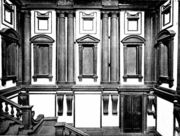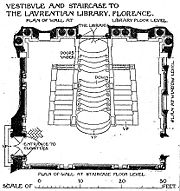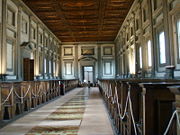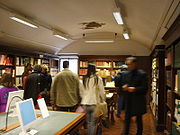
Laurentian Library
Encyclopedia

Florence
Florence is the capital city of the Italian region of Tuscany and of the province of Florence. It is the most populous city in Tuscany, with approximately 370,000 inhabitants, expanding to over 1.5 million in the metropolitan area....
, Italy
Italy
Italy , officially the Italian Republic languages]] under the European Charter for Regional or Minority Languages. In each of these, Italy's official name is as follows:;;;;;;;;), is a unitary parliamentary republic in South-Central Europe. To the north it borders France, Switzerland, Austria and...
, containing a repository of more than 11,000 manuscript
Manuscript
A manuscript or handwrite is written information that has been manually created by someone or some people, such as a hand-written letter, as opposed to being printed or reproduced some other way...
s and 4,500 early printed books. Built in a cloister of the Medicean Basilica di San Lorenzo di Firenze
Basilica di San Lorenzo di Firenze
The Basilica di San Lorenzo is one of the largest churches of Florence, Italy, situated at the centre of the city’s main market district, and the burial place of all the principal members of the Medici family from Cosimo il Vecchio to Cosimo III...
under the patronage of the Medici
Medici
The House of Medici or Famiglia de' Medici was a political dynasty, banking family and later royal house that first began to gather prominence under Cosimo de' Medici in the Republic of Florence during the late 14th century. The family originated in the Mugello region of the Tuscan countryside,...
pope, Clement VII, the Library was built to emphasize that the Medici
Medici
The House of Medici or Famiglia de' Medici was a political dynasty, banking family and later royal house that first began to gather prominence under Cosimo de' Medici in the Republic of Florence during the late 14th century. The family originated in the Mugello region of the Tuscan countryside,...
family were no longer mere merchants but members of intelligent and ecclesiastical society. It contains the manuscripts and books belonging to the private library of the Medici family. The library is renowned for the architecture planned and built by Michelangelo
Michelangelo
Michelangelo di Lodovico Buonarroti Simoni , commonly known as Michelangelo, was an Italian Renaissance painter, sculptor, architect, poet, and engineer who exerted an unparalleled influence on the development of Western art...
and is an example of Mannerism
Mannerism
Mannerism is a period of European art that emerged from the later years of the Italian High Renaissance around 1520. It lasted until about 1580 in Italy, when a more Baroque style began to replace it, but Northern Mannerism continued into the early 17th century throughout much of Europe...
.
Architecture
The Laurentian Library was commissioned in 1523 and construction began in 1525; however, when Michelangelo left Florence in 1534, only the walls of the reading room were complete. It was then continued by Tribolo, Basari, and Ammannati based on plans and verbal instructions from Michelangelo. The library opened by 1571. In this way, the library integrates parts executed by Michelangelo with others built much later in an interpretation of his instructions. The Laurentian Library is one of Michelangelo's most important architectural achievements. Even Michelangelo's contemporaries realized that the innovations and use of space in the Laurentian Library were revolutionary.
The admirable distribution of the windows, the construction of the ceiling, and the fine entrance of the Vestibule can never be sufficiently extolled. Boldness and grace are equally conspicuous in the work as a whole, and in every part; in the cornices, corbels, the niches for statues, the commodious staircase, and its fanciful division-in all the building, as a word, which is so unlike the common fashion of treatment, that every one stands amazed at the sight thereof. – Giorgio Vasari.
The two-story Quattrocento cloister was to remain unchanged by the addition of the library. Because of this, certain features of Michelangelo’s plan such as the length and width were already laid out. Therefore walls were built on already pre-existing walls and cloisters. Because the walls were built on pre-existing walls, recessing the columns into the walls was a structural necessity. This also led to a unique style and pattern that Michelangelo takes advantage of.

Vestibule
The vestibule, also known as the ricetto, is 19.50 m. long, 20.30 m. wide, and 14.6 m. tall (31 by 34 by 44 feet). It was built above existing monastic quarters on the east range of the cloister, with an entrance from the upper level of the cloisters. Originally, Michelangelo had planned for a skylight but the Pope believed that it would cause the roof to leak so clerestory windows were incorporated into the west wall. Blank tapering windows framed in peitra serena, circumscribe the interior of the vestibule, separated by paired columns set into the wall.Lit by windows in bays that are articulated by pilasters corresponding to the beams of the ceiling, with a tall constricted vestibule
Vestibule (architecture)
A vestibule is a lobby, entrance hall, or passage between the entrance and the interior of a building.The same term can apply to structures in modern or ancient roman architecture. In modern architecture vestibule typically refers to a small room or hall between an entrance and the interior of...
(executed to Michelangelo's design in 1559 by Bartolomeo Ammanati
Bartolomeo Ammanati
Bartolomeo Ammannati was an Italian architect and sculptor, born at Settignano, near Florence. He studied under Baccio Bandinelli and Jacopo Sansovino and closely imitated the style of Michelangelo.He was more distinguished in architecture than in sculpture...
) that is filled with a stair that flows down from the library itself, the Library is often instanced as a prototype of Mannerism
Mannerism
Mannerism is a period of European art that emerged from the later years of the Italian High Renaissance around 1520. It lasted until about 1580 in Italy, when a more Baroque style began to replace it, but Northern Mannerism continued into the early 17th century throughout much of Europe...
in architecture.

Staircase
The plan of the stairs changed dramatically in the design stage. Originally in the first design in 1524, two flights of stairs were placed against the side walls and formed a bridge in front of the reading room door. A year later the stairway was moved to the middle of the vestibule. Tribolo attempted to carry out this plan in 1550 but nothing was built. Ammannati took on the challenge of interpreting Michelangelo’s ideas to the best of his ability using a small clay model, scanty material, and Michelangelo’s instructions.The staircase leads up to the reading room and takes up half of the floor of the vestibule. The treads of the center flights are convex and vary in width, while the outer flights are straight. The three lowest steps of the central flight are wider and higher than the others, almost like concentric oval slabs. As the stairway descends, it divides into three flights.

Reading Room
The reading room is 46.20 m. long, 10.50 m. wide, and 8.4 m. high (152 by 35 by 28 feet). There are two blocks of seats separated by a center aisle with the backs of each serving as desks for the benches behind them. The desks are lit by the evenly spaced windows along the wall. The windows are framed by pilasters, forming a system of bays which articulate the layout of the ceiling and floor.Because the reading room was built upon an existing story, Michelangelo had to reduce the weight of the reading-room walls. The system of frames and layers in the walls’ articulation reduced the volume and weight of the bays between the pilasters.
Beneath the current wooden floor of the library in the Reading Room is a series of 15 rectangular red and white terra cotta
Terra cotta
Terracotta, Terra cotta or Terra-cotta is a clay-based unglazed ceramic, although the term can also be applied to glazed ceramics where the fired body is porous and red in color...
floor panels. These panels, measuring 8 foot-6-inches (2.6 m) on a side, when viewed in sequence demonstrate basic principles of geometry
Geometry
Geometry arose as the field of knowledge dealing with spatial relationships. Geometry was one of the two fields of pre-modern mathematics, the other being the study of numbers ....
. It is believed that these tiles were arranged so as to be visible under the original furniture; but this furniture was later changed to increase the number of reading desks in the room.
Interpretation
In the ricetto, critics have noted that the recessing columns into the walls made the walls look like taut skin stretched between vertical supports. This caused the room to appear as if it mimics the human body, which at the time of the Italian RenaissanceItalian Renaissance
The Italian Renaissance began the opening phase of the Renaissance, a period of great cultural change and achievement in Europe that spanned the period from the end of the 13th century to about 1600, marking the transition between Medieval and Early Modern Europe...
was believed to be the ideal form. The columns of the building also appear to be supported on corbels so that the weight seems to be carried on weak elements. Because of the seemingly instability of the structure, the viewer cannot discern whether the roof is supported by the columns or the walls. This sense of ambiguity is heightened by the unorthodox forms of the tabernacle windows and of the architectural elements compressed together, creating a sense of tension and constrained energy.
The dynamic sculpture of the staircase appears to pour forth from the upper level like lava and compress the floor space of the vestibule. In the central flight, the convex treads vary in width which makes the entire arrangement disquieting.
In sharp contrast to the vestibule and staircase, the reading room’s evenly spaced windows set between pilasters in the side walls is amplified by natural light and gives it a serene, quiet, and restful appearance.

Collection
In 1571, Cosimo I, Grand Duke of Tuscany, opened the still-incomplete Library to scholars. Notable additions to the collection were made by its most famous librarian, Angelo Maria BandiniAngelo Maria Bandini
Angelo Maria Bandini was an Italian author and librarian born in Florence.Having been left an orphan in his infancy, he was supported by his uncle, Giuseppe Bandini, a lawyer of some note. He received his education among the Jesuits, and showed a special inclination for the study of antiquities...
, who was appointed in 1757 and oversaw its printed catalogues. The Library conserves the Nahuatl
Nahuatl
Nahuatl is thought to mean "a good, clear sound" This language name has several spellings, among them náhuatl , Naoatl, Nauatl, Nahuatl, Nawatl. In a back formation from the name of the language, the ethnic group of Nahuatl speakers are called Nahua...
Florentine Codex
Florentine Codex
The Florentine Codex is the common name given to a 16th century ethnographic research project in Mesoamerica by Franciscan friar Bernardino de Sahagún. Bernardino originally titled it: La Historia General de las Cosas de Nueva Espana...
, the major source of pre-Conquest Aztec life. Among other well-known manuscripts in the Laurentian Library are the sixth-century Syriac Rabula Gospels
Rabula Gospels
The Rabbula Gospels, or Rabula Gospels, is a 6th century illuminated Syriac Gospel Book...
; the Codex Amiatinus
Codex Amiatinus
The Codex Amiatinus, designated by siglum A, is the earliest surviving manuscript of the nearly complete Bible in the Latin Vulgate version, and is considered to be the most accurate copy of St. Jerome's text. It is missing the Book of Baruch. It was produced in the Anglo-Saxon kingdom of...
, which contains the earliest surviving manuscript of the Latin Vulgate Bible
Vulgate
The Vulgate is a late 4th-century Latin translation of the Bible. It was largely the work of St. Jerome, who was commissioned by Pope Damasus I in 382 to make a revision of the old Latin translations...
; the Squarcialupi Codex
Squarcialupi Codex
The Squarcialupi Codex is an illuminated manuscript compiled in Florence, Italy in the early 15th century...
, an important early musical manuscript; and the fragmentary Erinna
Erinna
Erinna was a Greek poet, a contemporary and friend of Sappho, a native of Rhodes or the adjacent island of Telos or even possibly Tenos, who flourished about 600 BC...
papyrus containing poems of the friend of Sappho
Sappho
Sappho was an Ancient Greek poet, born on the island of Lesbos. Later Greeks included her in the list of nine lyric poets. Her birth was sometime between 630 and 612 BC, and it is said that she died around 570 BC, but little is known for certain about her life...
.
See also
- Papyrus 35
- Papyrus 36
- Papyrus 89
- Uncial 0171Uncial 0171Uncial 0171 , ε 07 is two vellum leaves of a late third century Greek uncial codex containing fragments Matthew and Luke. In the Berlin Matthew and Florence Luke are taken. Matthew is a part of the Medici Library collection in Florence, Luke – Staatliche Museen zu Berlin Uncial 0171 (in the...
- Minuscule 619Minuscule 619Minuscule 619 , α 57 , is a Greek minuscule manuscript of the New Testament, on parchment. It is dated by a colophon to the 984. The manuscript has complex contents. Tischendorf labelled it by 148a and 184p....
External links
- Official website (in English)
- Great Buildings on-line: Laurentian Library
- Photos of the Library and vestibule, with Giorgio Vasari's remarks
- Art of the States: Octet for Strings 'La Laurenziana' Work by composer Henri Lazarof inspired by the library
- Laurentian Library

